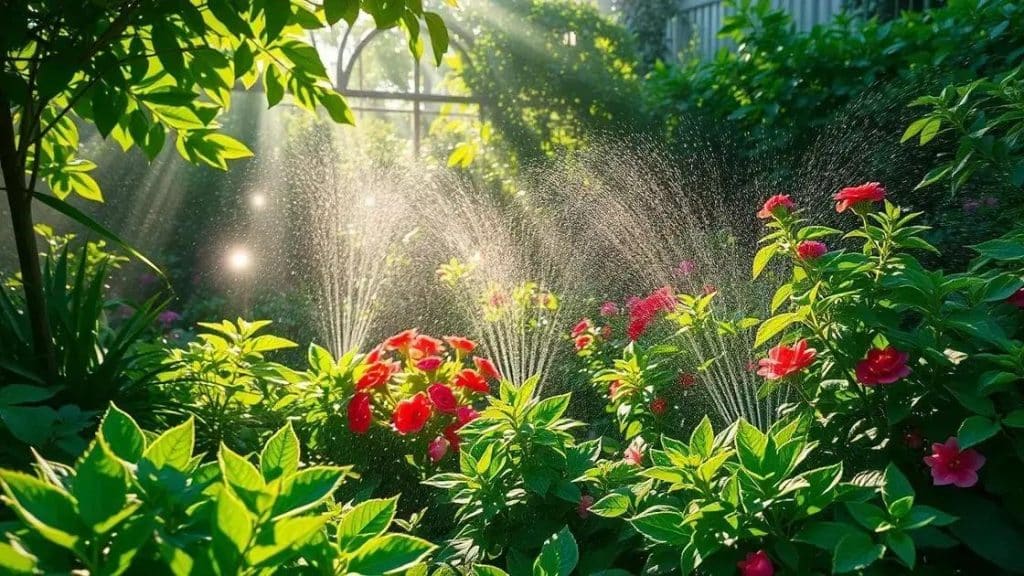Automated irrigation control systems: A gardener’s best ally

Automated irrigation control systems optimize water usage and ensure healthy plants by adjusting watering schedules based on weather and soil conditions, making gardening more efficient and sustainable.
Automated irrigation control systems can transform the way you manage your garden’s watering needs. Imagine saving time while ensuring your plants thrive with precision watering. Let’s explore how these systems work and why they might be the solution you’ve been looking for.
Understanding automated irrigation control systems
When it comes to maintaining a healthy garden, understanding automated irrigation control systems is essential. These systems not only save you time but also ensure your plants receive the right amount of water. Let’s dive into how these systems work and why they are beneficial for any gardener.
What are automated irrigation control systems?
Automated irrigation control systems are designed to manage the irrigation process automatically. This means you can program the system to water your plants at specific times, making gardening easier and more efficient.
Components of an automated irrigation system
- Controllers: The brain of the system, allowing you to set schedules.
- Sensors: Devices that monitor soil moisture and weather conditions.
- Valves: Mechanisms that open and close to control water flow.
- Drip lines or sprinklers: Delivery systems that distribute water to your plants.
Every part plays a crucial role in ensuring that your garden is adequately watered while conserving resources. Understanding these components can help you select the right system for your garden.
Many homeowners are opting for automated irrigation control systems because they can be customized to fit different garden sizes and plant types. This customization helps in maintaining a healthy garden without wasting water. For instance, if you have a vegetable garden, you will need different moisture levels compared to a flower garden.
Benefits of using automated irrigation control systems
A significant advantage of these systems is that they help conserve water. By using sensors, the system only waters when necessary, preventing overwatering. This can lead to reduced water bills and a more sustainable gardening practice.
Moreover, automated irrigation control systems enhance plant health. When plants receive consistent moisture, they grow better and are less susceptible to disease. Additionally, these systems free up your time, allowing you to focus on other gardening tasks or simply enjoy your garden.
Incorporating automated irrigation control systems into your gardening routine can lead to healthier plants and a more efficient watering process. Understanding how they work empowers you to make informed decisions about your garden’s irrigation needs.
Benefits of automated irrigation for your garden

Understanding the benefits of automated irrigation for your garden can greatly enhance your gardening experience. This technology allows for smarter watering, leading to healthier plants and efficient use of resources. Many gardeners are turning to automated solutions for a good reason.
Water conservation
One of the primary advantages is water conservation. Automated systems can monitor moisture levels and adjust watering schedules accordingly. This means less water waste and lower utility bills.
Improved plant health
Consistent watering is vital for plant growth. Automated irrigation systems ensure that plants receive the right amount of water at the right time. This consistency helps prevent issues like root rot caused by overwatering and dry patches from under-watering.
- Reduces stress on plants.
- Encourages deeper root growth.
- Lowers the risk of fungal diseases.
Additionally, with an automated system, you can program specific watering times to match the needs of different plant species. Some plants require more water than others, and these settings can help tailor the irrigation process precisely.
Time savings
The time savings provided by automated irrigation is significant. You no longer need to spend hours watering your garden by hand. Instead, set your system and let it do the work for you. This freedom allows you more time to enjoy your garden or tend to other tasks.
Many systems can be controlled remotely. This means you can adjust settings right from your smartphone, whether you’re at home or away. Imagine being on vacation but still knowing your garden is being well taken care of!
Increased efficiency
Overall, automated systems offer increased efficiency in how you manage your garden’s watering needs. They can navigate challenging weather conditions, adjusting watering schedules based on rain forecasts or current humidity. With integrated sensors, automated irrigation becomes a smart choice for any passionate gardener.
Integrating automation into your watering routine not only elevates your gardening efforts but also brings peace of mind knowing that your plants thrive with minimal input.
Choosing the right system for your needs
Choosing the right automated irrigation control system for your needs is crucial for successful gardening. With many options available, understanding your specific requirements can help you make an informed decision. Various factors influence what type of system will work best for your garden.
Consider your garden size
The size of your garden plays a significant role in determining the best irrigation system. A small garden may only need basic drip irrigation, while a larger space might require a more advanced setup with multiple zones. Assessing the square footage will help you narrow down your choices.
Evaluate your plant types
The types of plants you grow also impact your irrigation choices. Different plants have different moisture needs. For instance, vegetables often require more water than succulents. A system that allows for customization can better accommodate the various needs of your plants.
- Flowers: Require consistent moisture.
- Vegetables: Need frequent watering during certain growth stages.
- Succulents: Benefit from less frequent watering.
Finding a system that allows for variable watering schedules is beneficial in ensuring that all your plants thrive.
Look for technological features
Modern automated irrigation control systems can come with a range of advanced features. Look for systems with moisture sensors, timers, and remote access via smartphone apps. These features add convenience and efficiency to your watering routine.
For example, moisture sensors can detect when the soil is dry, and automatically adjust the watering schedule. This technology can help conserve water and promote healthier plants.
Budget considerations
While it’s tempting to choose the cheapest option, investing in a quality system can save money in the long run. More expensive systems often come with better technology and durability. Think about your budget, but also consider the long-term benefits of a well-designed irrigation system.
Ultimately, choosing the right system involves assessing your garden’s size, understanding your plants’ watering needs, considering available technology, and factoring in your budget. Taking the time to evaluate these elements will lead you to a suitable irrigation solution that meets your gardening goals.
Best practices for installation and maintenance

Implementing best practices for installation and maintenance of your automated irrigation control system is essential for ensuring its efficiency and longevity. Proper installation sets the foundation for optimal performance, while regular maintenance keeps your system running smoothly.
Installation tips
When you start the installation process, make sure to plan your layout carefully. Identify the areas that require watering and ensure that your system reaches every plant. Marking the locations for water lines, sensors, and controllers will make the installation process easier.
Check your water source
Before installation, it’s important to test your water source pressure and quality. Ensure that your water supply meets the requirements for your irrigation system. If your pressure is too low, you might need a pump for optimal performance.
- Install timers: Setting up timers will automate the watering schedule.
- Use quality materials: Invest in durable hoses and connectors to prevent leaks.
- Position sensors wisely: Place moisture sensors in representative areas of your garden for accurate readings.
Taking time to select high-quality components and using the right tools will result in better installation and fewer issues down the line.
Regular maintenance practices
The key to a well-functioning irrigation system is regular maintenance. Inspect your system frequently for any signs of wear or damage. Look for leaks, clogs, or broken components. Addressing these issues promptly can prevent larger problems later.
Additionally, cleaning filters and nozzles will ensure water flows freely. Depending on the type of system, you may need to flush the lines periodically to clear any buildup of mineral deposits or debris.
Seasonal checks
Before the start of every season, check your entire system. Adjust the watering schedules according to the changing weather conditions. This is especially important during the summer months when plants may require more water.
By following these best practices for installation and maintenance, you can maximize the efficiency of your automated irrigation control system, ensuring that your garden thrives throughout the growing season.
In summary, adopting automated irrigation control systems can greatly enhance your gardening experience. These systems not only save water, but they also ensure that your plants receive the right amount of hydration. Proper installation and maintenance are key to maximizing their benefits. By understanding your garden’s needs and following best practices, you can enjoy a flourishing garden with less effort. Investing time in getting the right system will pay off in healthier plants and a more enjoyable gardening experience.
FAQ – Frequently Asked Questions about Automated Irrigation Control Systems
What are automated irrigation control systems?
Automated irrigation control systems manage watering automatically, adjusting schedules based on weather and soil conditions, ensuring efficient water use.
How do I choose the right system for my garden?
Consider factors like garden size, plant types, and available technology. Evaluate your water source and explore options that fit your specific needs.
What maintenance is required for these systems?
Regular checks for leaks, clogs, and cleaning filters are essential. Seasonal inspections help ensure the system operates effectively throughout the year.
Can automated systems save me money?
Yes, by conserving water and reducing utility costs, these systems can lead to savings in your water bills over time while enhancing plant health.





